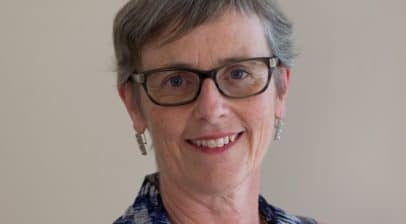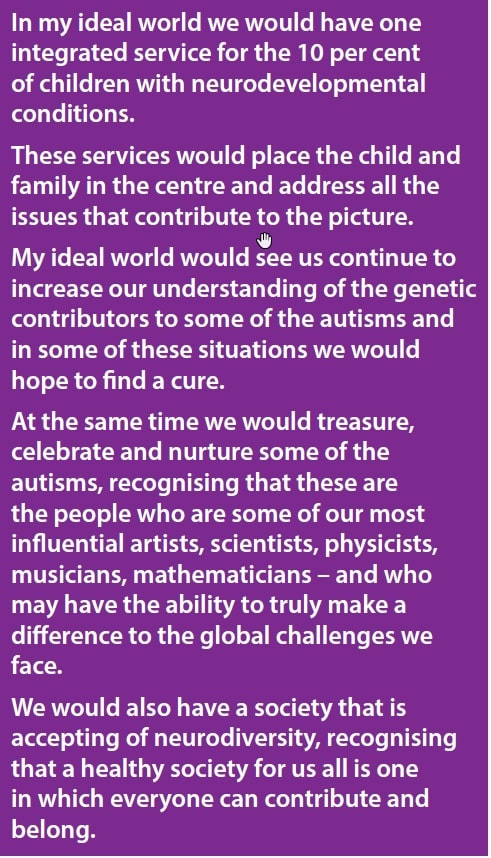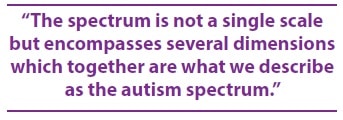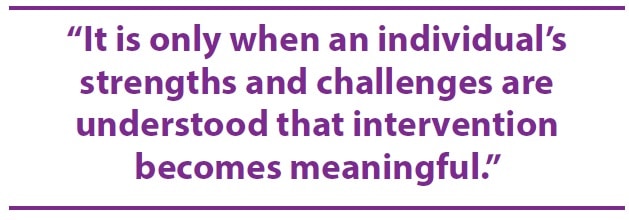
Autism Spectrum Disorder[1] (ASD) as a diagnosis and the way in which we provide services for people pre and post diagnosis is a huge topic which is not easily covered in one article, but I have tried to share some of my current thinking on these issues.
This is largely informed by my clinical practice but with a nod to the extensive research on the topic and conversations amongst those who work in the field.
I am mindful that autistic people have much to say on these matters too but I have not specifically addressed this point of view here.
As my working life has been spent working with young children my comments are made primarily with this group in mind but there is likely to be some relevance to adult diagnosis and service provision too.
Thinking about the future necessarily involves a revisit of the past. As a clinician who has worked in a child development service for the past 30 years I have had the pleasure of meeting a great number of children who have what are currently broadly described as the neurodevelopmental conditions– in other words differences in brain functioning that they are born with and which become apparent as the child develops and grows.
Over the years, I have seen first-hand the changes in the way in which the neurodevelopmental conditions (of which autism is currently the most well known) are described, understood and diagnosed, and the way in which services for these diagnoses are allocated and delivered. There are a number of factors that have contributed to these changes.
History of autism as a diagnosis
The collection of characteristics we now understand as autism was first described by Leo Kanner and Hans Asperger in the 1940s.
At that time autism was regarded as a rare condition, affecting just four or five people in 10,000. Rates of diagnosis did not change until the 1980s, following the publication of the third edition of the most commonly referenced diagnostic guide, the Diagnostic and Statistical Manual of Mental Disorders (DSM-III) in 1980 (DSM-III, 1980).
Interestingly autism did not in fact feature as a formal diagnosis until the DSM-III; in the first two editions of the DSM, autism was conceptualised as childhood schizophrenia. In the DSM-III, the term “Infantile Autism” was introduced. The way the diagnosis was described meant it could only ever be a rare condition – the diagnostic criteria required a child to have “gross deficits in language development” as well as “bizarre responses to the environment.” The term “infantile” also meant that it was viewed only as a condition of early childhood. The diagnostic criteria was broadened in 1987 with a revised edition of the DSM; the DSM-III-R (DSM-III-R, 1987). “Infantile Autism” was gone, replaced by “Autistic Disorder”, a term which implied a lifelong condition and which had expanded criteria that could be applied to a much larger and more diverse group of the population.
The fourth edition of the Diagnostic and Statistical Manual (DSM-IV, 1994) introduced four different disorders; Autistic Disorder, Asperger’s Disorder, Childhood Disintegrative Disorder and Pervasive Developmental Disorder Not Otherwise Specified (PDD-NOS).
This meant that children of normal intelligence, with superficially normal language development and those who had some autism symptoms but not all of them could now be diagnosed.
The most recent edition of the Diagnostic and Statistical Manual, the DSM-5, published in 2013, (DSM-5, 2013) dropped the terms Autistic Disorder, Aspergerʼs Disorder and PDDNOS diagnoses and replaced all of these with one new, overarching criterion, known simply as Autism Spectrum Disorder.
Although this change was controversial, it arose out of the prevailing view at the time that autism is best understood as a spectrum condition, with varying numbers of autism symptoms[2] and varying levels of functional impairment (the rather unpleasant term that is used to describe how much an individual is impacted, on a day to day basis, by their symptoms.)
The notion of a spectrum can be somewhat problematic as it leads to the question “where on ‘the spectrum’ is my child?” when in fact ‘the spectrum’ is not a single scale but encompasses several dimensions which together are what we describe as the autism spectrum – these include variances in sociability, sensory processing, intellectual ability and language ability just to name a few.
The DSM-5 for the first time, also allowed for an autism diagnosis to be made in the presence of so-called comorbid conditions such as Attention Deficit Hyperactivity Disorder (ADHD) and intellectual disability and anxiety; previously these were either/or diagnoses, not both or several. This inclusion of comorbidities has had significant implications for services, a point I will return to later.
Changing rates of diagnosis
As the diagnostic criteria for autism changed so did the prevalence rates. The Centre for Disease Control and Prevention (CDC) in the USA began publishing prevalence rates for autism in 2000. Rates were approximately one in 150 in 2000; one in 88 in 2008; one in 68 in 2012 and one in 59 in 2019.
These increasing rates resulted in headlines about whether we are experiencing an “autism epidemic” and spawned many theories, some speculative and some with some evidence behind them, about why this increase is occurring. The claim that the Measles Mumps and Rubella (MMR) vaccine causes autism (which has been extensively studied and debunked by the scientific community) is one of the most well known of these.
Most clinicians and researchers are of the view that the changing rates of diagnosis are primarily to do with the changing criteria over time. Essentially this view implies that these children have always existed but historically they may not have been diagnosed or if they were, they may have been diagnosed with something else. This is known as diagnostic substitution. There is much good evidence for diagnostic substitution. For example, as rates of autism have increased, rates of diagnosis of intellectual disability have correspondingly decreased (Coo, Ouellette-Kuntz, Lloyd, Kasmara, Holden, et al, 2008).
Another driver for increasing rates of diagnosis is the emergence of services specifically available for people with autism. A dramatic increase in rates of autism diagnosis occurred in the USA in 1991, when the Department of Education ruled that a diagnosis of autism qualified for special education services. Many of the children who were now diagnosed with autistic disorder had previously been diagnosed with intellectual disability.
We do not have good New Zealand data on the prevalence of ASD. However, the government announcement in February 2014 confirming that Autistic Spectrum Disorder (ASD) is eligible for needs assessment is believed to be a key driver behind the ever increasing number of new ASD clients being referred to Disability Support Services.
Growing public awareness of autism has led to an increase in the numbers of referrals. The New Zealand Autism Guidelines published in 2008 (New Zealand Autism Spectrum Disorder Guideline, 2008) and revised in 2016 (New Zealand Autism Spectrum Disorder Guideline, 2016) raised awareness amongst health and education professionals. Parents are also recognising the signs themselves and requesting referral.
So with New Zealand likely following similar trajectories to the USA and the UK, and with rates of diagnosis estimated at one in 100 children, what does this mean for autism diagnosis in NZ?
An obvious impact for those working in child development and paediatric services across the country are the lengthy and growing waiting lists for formal diagnosis.
Furthermore, these changes mean that the group of children receiving an ASD diagnosis are increasingly diverse.
Within the group of children being referred for an autism assessment, it means there are a substantial minority who will not get an ASD diagnosis, although they may have some significant difficulties.
These children may have some autism symptoms but do not have enough to meet full criteria for ASD. (The extended families of people with an autism diagnosis are often full of quirky people who fit into this category).
A child who does not have functional impairment from their autism symptoms across settings, for example the child who copes at school but not at home, will not meet criteria for ASD.
Similarly, older children with autistic traits presenting for assessment later in life but who have no evidence of social communication and social interaction concerns in their early years, may not meet criteria for ASD.
A child may have some ASD symptoms as well as comorbid anxiety or ADHD symptoms, and then seem to “fall between” the child mental health and developmental services, and may not meet entry criteria for either service despite having significant needs. There is pressure for clinicians to give a formal diagnosis of ASD to these children, because ASD, along with intellectual disability, is a recognised pathway by which additional services can be accessed.
Despite our best attempts to assure parents that we hear and believe their concerns, many feel their concerns have not been validated if the diagnosis of ASD is not made. Those who do get their diagnosis are often disappointed when they find that there are not specific targeted supports as they had hoped. Unfortunately, there are simply not the resources available for specific supports for all people with ASD. In NZ special education resources are guaranteed only for the most severely disabled children (usually those with a severe intellectual or physical disability).
Similarly in health, a diagnosis of ASD simply means one is eligible to be considered for disability supports; once again it is those who are the most severely disabled who can expect significant support. There are of course other good reasons for parents to seek diagnosis for their child besides access to services– understanding for themselves and others who have a relationship with them, guidance on strategies that may be supportive and improvement of quality of life.
Where to from here?
Given the changes in diagnosis in the past 20 years it is likely that in another 20 years there will be further changes to the way we think about autism.
The current very broad conceptualisation of autism as a spectrum condition and as a condition with many associated conditions has I believe made the current diagnosis of ASD of limited utility[3]
One size does not fit all and approaching autism as a unified diagnosis with a single approach to intervention makes little sense and is not useful. The views of
Christopher Gillberg, a Swedish child psychiatrist resonate with me. Gillberg and others believe that there is not one condition called Autism Spectrum Disorder but in fact there are many autisms (Coleman and Gillberg, 2012)
Some of these autisms bring benefit to the individual and society – think of some of our most influential artists, scientists, physicists, musicians, mathematicians who may have the ability and focus to truly make a difference.
Others have “just a little bit of autism” and not “enough” to warrant access to disability or special education supports although it can be helpful to understand the learning styles and coping styles that might come with it. These are the people who are currently described as “on the spectrum” but do not meet full criteria for ASD.
Many of the autisms have associated conditions (learning difficulties, language difficulties, ADHD, anxiety) that are more troublesome than the autism itself and need to be the focus of intervention. In fact there are very few people in the world with autism only – having “autism plus” as Gillberg describes it is the rule rather than the exception.
Some of the autisms are associated with medical conditions (e.g. Fragile X, neurofibromatosis and some epilepsies).
With a focus on the diversity of the autisms we are better able to find meaningful ways to support this large and disparate group; it is only when an individual’s strengths and challenges are understood that intervention becomes meaningful. The concept of multiple autisms also enables us to address some issues that are difficult to openly discuss as they can be perceived as disabling or discriminatory or as parent blaming. For example there are a number of genetic causes for some of the severely disabling autisms that warrant research aimed at preventing the condition from occurring.
There is estimated to be around 10 per cent of the child population who present with a variety of neurodevelopmental problems – with general development, with communication and language, with social skills, with motor coordination, with attention, behaviour, mood and sleep. ASD is a common diagnosis in this group of children. However these children are not simple. They come from a diverse range of cultures, backgrounds, and families. Some come from well-off and well resourced families and neighbourhoods. Some grow up in situations of social adversity and may experience abuse and neglect. Indeed, research has found that adverse childhood experiences including living with someone with an alcohol or drug problem or mental illness are associated with higher rates of autism (Hoover and Kaufman, 2018). Intervention for parents and the parent child relationship may be needed as much or more than intervention for the neurodevelopmental condition itself.
Furthermore, while it appears that around 90 per cent of children with early neurodevelopmental problems will have some difficulties later on, we are not good at picking which problem(s) will be most significant later on (and therefore what diagnosis or diagnoses are useful) or how severe the challenges will be. Early intervention is important, but early diagnosis is not always accurate.
While we may be aware of the many factors that contribute to neurodevelopmental conditions in children and the need for broad based supports, our current siloed[4] funding streams mean we have increasingly specialised services and clinicians.
For example it is common for children to be seen in paediatric or child disability services for their autism and separately in child mental health services for their ADHD and anxiety. Clinicians in disability services do not necessarily have the skills and knowledge to adequately treat mental health conditions and mental health services are often not well-equipped to support autistic people.
Unfortunately, when services are under pressure they may try to manage overwhelming referral volumes by trying to redirect people e.g. “this child’s anxiety is arising in the context of their autism, so it should be managed within autism services.” Or conversely “this child’s autism symptoms are not enough to meet criteria for a formal diagnosis of ASD but they are anxious so they belong in mental health.”
The clinical reality is that symptom overlap is the norm not the exception and our services should reflect that.
In my ideal world we would have one integrated service for the 10 per cent of children with neurodevelopmental conditions.
These services would place the child and family in the centre and address all the issues that contribute to the picture.
My ideal world would see us continue to increase our understanding of the genetic contributors to some of the autisms and in some of these situations we would hope to find a cure.
At the same time we would treasure, celebrate and nurture some of the autisms, recognising that these are the people who are some of our most influential artists, scientists, physicists, musicians, mathematicians – and who may have the ability to truly make a difference to the global challenges we face.
We would also have a society that is accepting of neurodiversity, recognising that a healthy society for us all is one in which everyone can contribute and belong.
- Jenny Gibbs is a clinical psychologist who has worked at the Child Development Centre at Waikato Hospital for the past 30 years.
- This article first appeared in Altogether Autism Journal 3, 2019.
References
American Psychiatric Association (1980). Diagnostic and statistical manual of mental disorders (3rd ed). Washington, DC: Author.
American Psychiatric Association (1987). Diagnostic and statistical manual of mental disorders (3rd ed.,Text Revision). Washington, DC: Author.
American Psychiatric Association (2000). Diagnostic and statistical manual of mental disorders (4th ed., Text Revision). Washington, DC: Author.
American Psychiatric Association (2013) Diagnostic and Statistical Manual of Mental Disorders: Diagnostic and Statistical Manual of Mental Disorders, Fifth Edition. Arlington, VA: American Psychiatric Association
Coleman, M & Gillberg, C (2012) The Autisms, Oxford University Press, USA
Coo, Helen & Ouellette-Kuntz, Hélène & Lloyd, Jennifer & Kasmara, Liza & Holden, Jeanette & Lewis, M. E. Suzanne. (2008). Trends in Autism Prevalence: Diagnostic Substitution Revisited. Journal of autism and developmental disorders. 38. 1036-46. 10.1007/s10803-007-0478-x.
Hoover, D. W., & Kaufman, J. (2018). Adverse childhood experiences in children with autism spectrum disorder. Current opinion in psychiatry, 31(2), 128–132.
Ministries of Health and Education. 2016. New Zealand Autism Spectrum Disorder Guideline (2nd edn). Wellington: Ministry of Health.Ministries of Health and Education. 2008 New Zealand Autism Spectrum Disorder Guideline. Wellington: Ministry of Health.
[1] Throughout this article I have used the term Autism Spectrum Disorder (or the diagnostic term which was in use at the time under discussion) when speaking about formal diagnosis
[2] The term “symptoms” is used here as the diagnosis of Autism Spectrum Disorder is firmly entrenched within the medical model
[3] I am saying here that the diagnosis of ASD is of limited utility, not that neurodiversity and autism are of limited usefulness
[4] Silos are organisations where each department concentrates on their own objectives.





